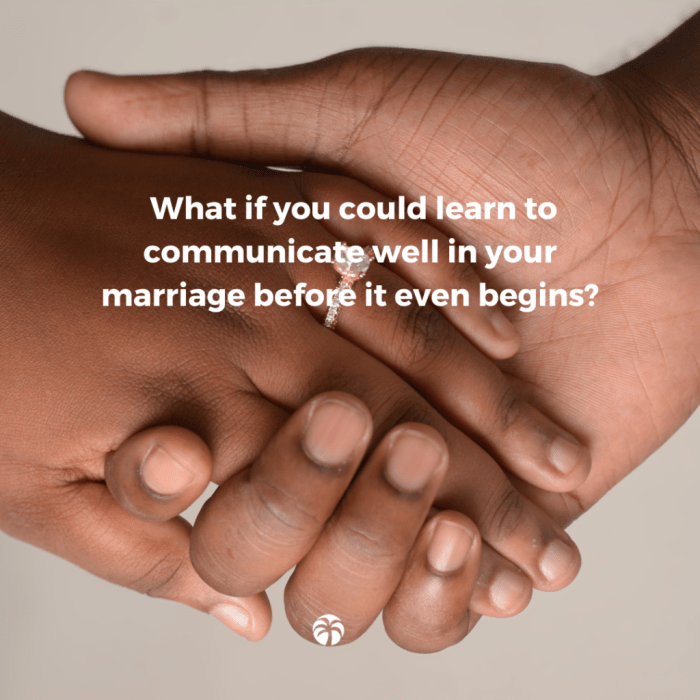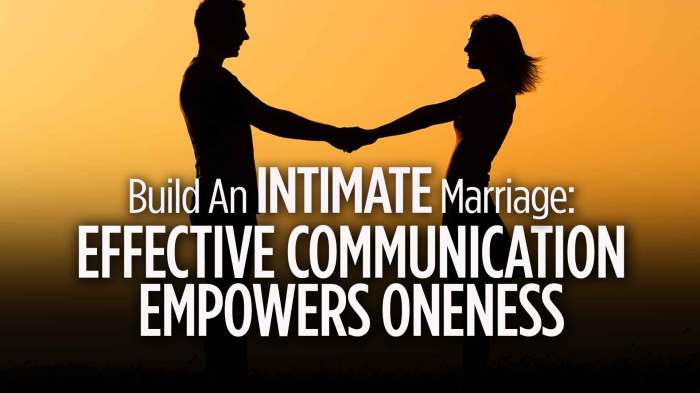Healthy Communication in Marriage: Building a Strong Foundation

Healthy communication in marriage is the cornerstone of a fulfilling and lasting relationship. It’s not just about exchanging words; it’s about understanding, respecting, and connecting on a deeper level. When couples learn to communicate effectively, they create a safe and supportive environment where they can navigate challenges, express their needs, and foster emotional intimacy.
This guide explores the key principles of healthy communication, from active listening and conflict resolution to building a foundation of mutual respect and understanding. It offers practical tips and strategies for couples to strengthen their connection and create a more harmonious and fulfilling marriage.
Understanding Healthy Communication

Healthy communication is the foundation of a strong and fulfilling marriage. It’s not just about talking; it’s about understanding, respecting, and connecting with your partner on a deeper level.
Principles of Effective Communication
Effective communication in marriage involves several core principles that contribute to a positive and supportive relationship.
- Openness and Honesty: Being open and honest with each other creates a safe space for vulnerability and trust. Sharing your thoughts, feelings, and concerns without judgment fosters intimacy and strengthens the bond.
- Respect and Empathy: Respecting your partner’s opinions and perspectives, even if you disagree, is crucial. Empathy involves understanding and acknowledging their feelings, even if you don’t fully agree with them.
- Active Listening: Active listening goes beyond simply hearing words; it involves paying attention to both verbal and non-verbal cues, asking clarifying questions, and demonstrating that you understand and care about what your partner is saying.
- Non-Judgmental Communication: Avoid blaming, criticizing, or putting your partner down. Instead, focus on expressing your needs and feelings in a constructive way. This fosters a positive and supportive environment for open communication.
- Constructive Conflict Resolution: Disagreements are inevitable in any relationship. Healthy communication involves finding constructive ways to resolve conflicts and focusing on solutions rather than blame. This might involve compromise, active listening, and finding common ground.
Examples of Healthy Communication Patterns
- “I” Statements: Instead of blaming, use “I” statements to express your feelings and needs. For example, instead of saying, “You always forget to take out the trash,” you could say, “I feel frustrated when the trash isn’t taken out, and I would appreciate it if we could work together to make sure it gets done.”
- Active Listening: When your partner is talking, show that you are paying attention by making eye contact, nodding, and asking clarifying questions. This demonstrates that you are truly listening and trying to understand their perspective.
- Regular Check-ins: Schedule regular time for open and honest communication. This could be a weekly “date night” or a brief check-in at the end of each day. This dedicated time allows for open dialogue and strengthens your connection.
- Compromise and Negotiation: When disagreements arise, focus on finding solutions that work for both of you. This might involve compromise, negotiation, or finding creative solutions that meet both of your needs.
Active Listening: Building a Strong Connection
Active listening is a fundamental skill in building a strong and loving connection. It demonstrates that you care about your partner’s thoughts and feelings, fostering trust and understanding.
- Pay Attention to Both Verbal and Non-Verbal Cues: Active listening involves observing not just the words your partner speaks but also their body language, tone of voice, and facial expressions. These cues can provide valuable insights into their emotions and underlying messages.
- Ask Clarifying Questions: To ensure you truly understand your partner’s perspective, ask open-ended questions that encourage them to elaborate. This demonstrates that you are engaged and interested in their thoughts and feelings.
- Reflect Back What You Hear: Summarize what your partner has said in your own words to confirm your understanding. This also allows them to clarify any misunderstandings and ensures that you are on the same page.
- Avoid Interrupting: Allow your partner to finish their thoughts without interruption. Interrupting can be disrespectful and can make them feel unheard. Patience and active listening are essential for building a strong connection.
- Focus on the Present: While past experiences can influence communication, try to focus on the current conversation and avoid bringing up past arguments or grievances. This helps keep the communication focused and productive.
Building a Foundation of Respect

Respect is the cornerstone of any healthy relationship, especially in marriage. It’s about valuing your partner, acknowledging their worth, and treating them with kindness and consideration. Building a foundation of respect requires a conscious effort from both partners, involving understanding, appreciation, and a willingness to communicate effectively.
Validating Each Other’s Feelings and Perspectives
Validating your partner’s feelings and perspectives is crucial for fostering mutual respect. It means acknowledging their emotions, even if you don’t agree with them, and demonstrating that you understand their point of view.
- Active Listening: Pay attention to what your partner is saying, both verbally and nonverbally. Ask clarifying questions to ensure you understand their perspective.
- Empathy: Try to see things from your partner’s point of view, even if you don’t share their feelings. Acknowledge their emotions by saying things like, “I understand you’re feeling frustrated right now.”
- Avoid Dismissal: Don’t dismiss your partner’s feelings as trivial or invalid. Even if you disagree, acknowledge their perspective and try to understand why they feel the way they do.
Handling Disagreements Respectfully, Healthy communication in marriage
Disagreements are inevitable in any relationship, but it’s how you handle them that matters. Respectful communication is key to navigating conflicts constructively.
- Choose Your Words Carefully: Avoid using hurtful language, name-calling, or blaming. Focus on expressing your feelings and needs calmly and respectfully.
- Take Breaks When Needed: If the conversation becomes heated, take a break to cool down and regain your composure. This will prevent the situation from escalating.
- Focus on Solutions: Instead of dwelling on the problem, work together to find solutions that address both of your needs.
- Respect Boundaries: Everyone has boundaries, and it’s important to respect your partner’s. If they need space, give it to them.
Effective Conflict Resolution

Conflict is a natural part of any relationship, and marriage is no exception. However, healthy communication is crucial for navigating disagreements and finding solutions that work for both partners. This section explores common communication pitfalls that can lead to conflict and provides a step-by-step guide for resolving conflicts constructively.
Common Communication Pitfalls
Understanding the pitfalls that can derail healthy communication is the first step toward resolving conflicts effectively. These pitfalls can range from subtle misunderstandings to overt hostility, and recognizing them is essential for preventing escalation and promoting understanding.
- Defensive Communication: This occurs when individuals react to criticism or feedback with hostility or denial, often blaming the other person or deflecting responsibility. For example, “It’s not my fault that we’re fighting, you always start these arguments.”
- Stonewalling: This involves withdrawing from the conversation and refusing to engage, often by remaining silent, changing the subject, or physically leaving the room. This can be incredibly frustrating for the other partner, leading to feelings of isolation and resentment. For example, “I’m not talking about this anymore, it’s pointless.”
- Condescending Communication: This involves talking down to the other person, using sarcasm, or belittling their opinions and feelings. This can be deeply hurtful and disrespectful, undermining the foundation of trust and respect in the relationship. For example, “You’re being ridiculous, just calm down.”
- Mind Reading: This occurs when individuals assume they know what their partner is thinking or feeling without actually asking. This can lead to misinterpretations and unnecessary arguments. For example, “You’re upset about what I said, even though I didn’t mean it that way.”
Constructive Conflict Resolution
When disagreements arise, it’s crucial to approach conflict resolution with a focus on understanding, empathy, and collaboration. This involves setting aside personal biases and actively listening to your partner’s perspective.
- Choose the Right Time and Place: Avoid addressing sensitive topics when either partner is stressed, tired, or distracted. It’s important to find a time and place where both partners feel safe and comfortable discussing the issue. For example, “Let’s talk about this later when we’ve both had a chance to calm down.”
- Focus on the Issue: Stick to the specific issue at hand, avoiding bringing up past grievances or unrelated topics. This helps keep the conversation focused and prevents the argument from spiraling out of control. For example, “Let’s talk about the way we’re handling the finances, not about what happened last week.”
- Active Listening: Pay attention to your partner’s perspective, acknowledging their feelings and attempting to understand their point of view. This involves asking clarifying questions and paraphrasing their statements to ensure you understand their message. For example, “It sounds like you’re feeling frustrated about the way I handle the chores, is that right?”
- Express Yourself Clearly: State your feelings and needs clearly and assertively, using “I” statements to avoid blaming or accusing your partner. For example, “I feel hurt when you don’t follow through on your promises.”
- Find Common Ground: Identify areas of agreement and work together to find solutions that address both partners’ needs. This may involve compromising on certain points or finding creative solutions that benefit both individuals. For example, “We both agree that we need to improve communication, so let’s try scheduling regular check-ins.”
- Take a Break If Needed: If the conversation becomes heated or unproductive, it’s okay to take a break and return to it later when both partners have had a chance to calm down and reflect. For example, “Let’s take a break and come back to this later when we’re both feeling calmer.”
Compromise and Mutually Beneficial Solutions
Compromise is an essential element of healthy conflict resolution. It involves both partners being willing to give up something to reach a mutually acceptable solution. This requires empathy, understanding, and a willingness to consider your partner’s needs.
“Compromise is the art of finding a solution that is not entirely satisfactory to either party.”
To find mutually beneficial solutions, it’s important to:
- Brainstorm Solutions: Work together to come up with a variety of potential solutions, focusing on options that address both partners’ needs. This may involve exploring different perspectives and considering creative solutions. For example, “What if we try splitting the chores differently?”
- Evaluate the Pros and Cons: Discuss the advantages and disadvantages of each potential solution, weighing the benefits and drawbacks for both partners. This helps ensure that the chosen solution is fair and addresses the needs of both individuals. For example, “If we split the chores differently, it would give me more time for my hobbies, but it might mean you have to work a bit longer on the weekends.”
- Negotiate and Adjust: Be willing to negotiate and adjust your initial position based on your partner’s needs and concerns. This may involve finding a compromise that is not ideal for either partner but is acceptable to both. For example, “I’m willing to take on more of the cooking if you’re willing to help with the yard work.”
Navigating Challenges and Growth: Healthy Communication In Marriage

Communication is the bedrock of a strong and healthy marriage, particularly when facing challenges. It provides a platform for understanding, empathy, and collaboration, enabling couples to navigate difficulties effectively and emerge stronger.
Communication as a Tool for Overcoming Challenges
Communication plays a crucial role in overcoming challenges by facilitating open and honest dialogue, fostering empathy, and promoting collaborative problem-solving. When couples can effectively communicate their needs, concerns, and perspectives, they can work together to find solutions that address the root of the issue.
For instance, if a couple is facing financial difficulties, open communication can help them understand each other’s financial habits, set realistic budgets, and explore potential solutions together.
Communication Supporting Personal Growth Within the Relationship
Communication is a powerful tool for personal growth within a relationship. It allows couples to express their feelings, share their aspirations, and support each other’s personal development. When partners feel comfortable and safe to share their vulnerabilities and dreams, they can create an environment of mutual understanding and encouragement.
For example, if one partner is pursuing a new career path, open communication can provide the necessary support, encouragement, and understanding from their partner, fostering personal growth and strengthening the bond.
Strategies for Effective Communication During Stressful Periods
Stressful periods can put a strain on any relationship. However, effective communication can help couples navigate these challenging times with grace and resilience.
- Active Listening: During stressful periods, it is crucial to practice active listening, paying attention to both verbal and non-verbal cues. This involves focusing on your partner’s words, understanding their perspective, and acknowledging their feelings.
- “I” Statements: Expressing feelings using “I” statements, such as “I feel hurt when…” or “I feel overwhelmed when…”, can help avoid blame and promote constructive dialogue.
- Taking Breaks: If emotions are running high, taking a break to calm down and collect thoughts can prevent escalation and allow for a more productive conversation later.
- Seeking Professional Help: If communication breakdowns persist despite efforts, seeking professional help from a therapist or counselor can provide valuable tools and strategies for navigating challenges effectively.
End of Discussion

Ultimately, healthy communication in marriage is a journey, not a destination. It requires ongoing effort, patience, and a willingness to learn and grow together. By embracing the principles articulated in this guide, couples can cultivate a deeper understanding of each other, strengthen their bond, and build a lasting foundation for a happy and fulfilling marriage.
Comments are closed.